
Wetenschap
Observatoria rond het zonnestelsel werken samen om de invloed van de zon te bestuderen
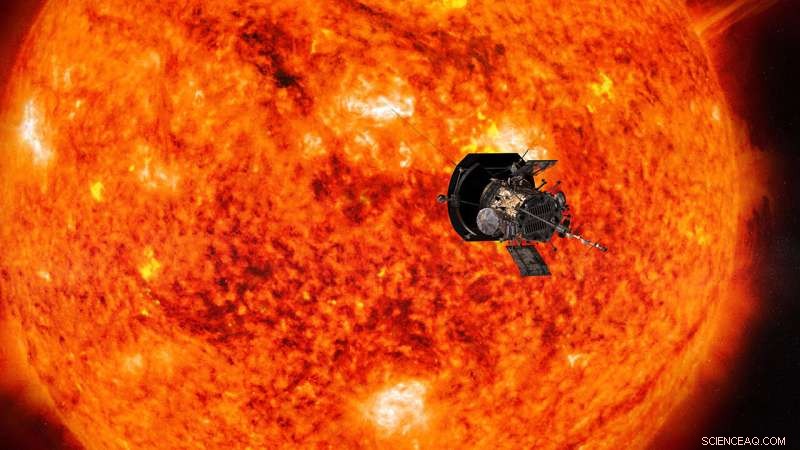
Illustratie van Parker Solar Probe die de zon nadert. Krediet:NASA/Johns Hopkins APL/Steve Gribben
De kern van het begrijpen van onze ruimteomgeving is de wetenschap dat de omstandigheden in de ruimte - van de zon tot de atmosferen van planeten tot de stralingsomgeving in de verre ruimte - met elkaar verbonden zijn.
Het bestuderen van dit verband - een wetenschapsgebied dat heliofysica wordt genoemd - is een complexe taak:onderzoekers volgen plotselinge uitbarstingen van materiaal, straling, en deeltjes tegen de achtergrond van de alomtegenwoordige uitstroom van zonnemateriaal.
Een samenloop van gebeurtenissen begin 2020 creëerde een bijna ideaal ruimtelaboratorium, het combineren van de uitlijning van enkele van de beste observatoria van de mensheid, waaronder Parker Solar Probe, tijdens zijn vierde zonnevlucht - met een rustige periode in de activiteit van de zon, wanneer het het gemakkelijkst is om die achtergrondomstandigheden te bestuderen. Deze omstandigheden boden wetenschappers een unieke kans om te onderzoeken hoe de zon de omstandigheden op punten in de ruimte beïnvloedt, met meerdere waarnemingshoeken en op verschillende afstanden van de zon.
De zon is een actieve ster waarvan het magnetische veld door het hele zonnestelsel is verspreid, gedragen binnen de constante uitstroom van materiaal van de zon, de zonnewind genaamd. Het beïnvloedt ruimtevaartuigen en vormt de omgeving van werelden in het hele zonnestelsel. We hebben de zon geobserveerd, ruimte nabij de aarde en andere planeten, en zelfs de meest afgelegen randen van de invloedssfeer van de zon gedurende tientallen jaren. En 2018 markeerde de lancering van een nieuwe, baanbrekend observatorium:Parker Solar Probe, met een plan om uiteindelijk tot ongeveer 3,83 miljoen mijl van het zichtbare oppervlak van de zon te vliegen.
Parker heeft nu vier nauwe ontmoetingen met de zon gehad. (De gegevens van Parker's eerste ontmoetingen met de zon hebben al een nieuw beeld van zijn atmosfeer onthuld.) Tijdens zijn vierde zonne-ontmoeting, verspreid over delen van januari en februari 2020, het ruimtevaartuig passeerde rechtstreeks tussen de zon en de aarde. Dit gaf wetenschappers een unieke kans:de zonnewind die Parker Solar Probe heeft gemeten toen hij het dichtst bij de zon was, zou dagen later, op aarde aankomen, waar de wind zelf en de effecten ervan kunnen worden gemeten door zowel ruimtevaartuigen als observatoria op de grond. Verder, zonne-observatoria op en nabij de aarde zouden een duidelijk zicht hebben op de locaties op de zon die de zonnewind produceerden, gemeten door Parker Solar Probe.
"We weten uit Parker-gegevens dat er bepaalde structuren zijn die hun oorsprong vinden op of nabij het zonneoppervlak. We moeten naar de brongebieden van deze structuren kijken om volledig te begrijpen hoe ze zich vormen, ontwikkelen, en bijdragen aan de plasmadynamiek in de zonnewind, " zei Nour Raouafi, projectwetenschapper voor de Parker Solar Probe-missie bij het Johns Hopkins Applied Physics Laboratory in Laurel, Maryland. "Op de grond gebaseerde observatoria en andere ruimtemissies bieden ondersteunende observaties die kunnen helpen om een volledig beeld te krijgen van wat Parker waarneemt."
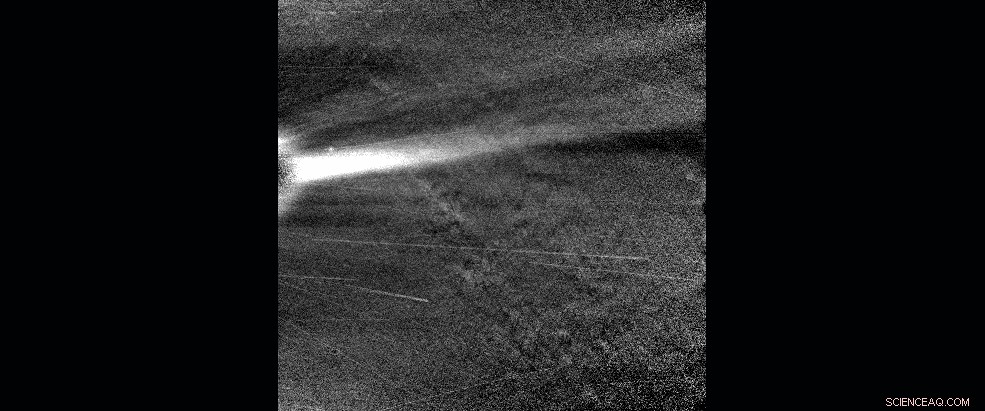
Deze geanimeerde reeks beelden van zichtbaar licht van het WISPR-instrument van Parker Solar Probe toont een coronale streamer, waargenomen toen Parker Solar Probe op 28 januari in de buurt van het perihelium was, 2020. Krediet:NASA/Johns Hopkins APL/Naval Research Lab/Parker Solar Probe
Deze hemelse uitlijning zou onder alle omstandigheden van belang zijn voor wetenschappers, maar het viel ook samen met een andere astronomische periode die van belang is voor wetenschappers:zonneminimum. Dit is het punt tijdens de regelmatige zon, ongeveer 11-jarige cycli van activiteit wanneer de zonneactiviteit op het laagste niveau is - dus plotselinge uitbarstingen op de zon zoals zonnevlammen, coronale massa-ejecties en energetische deeltjesgebeurtenissen zijn minder waarschijnlijk. En dat betekent dat het bestuderen van de zon nabij het zonneminimum een zegen is voor wetenschappers die een eenvoudiger systeem kunnen bekijken en zo kunnen ontrafelen welke gebeurtenissen welke effecten veroorzaken.
"Deze periode biedt perfecte omstandigheden om de zonnewind van de zon naar de aarde en de planeten te volgen, " zei Giuliana de Toma, een zonnewetenschapper bij het High Altitude Observatory in Boulder, Colorado, die de coördinatie tussen observatoria leidde voor deze observatiecampagne. "Het is een tijd waarin we de zonnewind gemakkelijker kunnen volgen, omdat we geen last hebben van de zon."
Al decenia, wetenschappers hebben observaties verzameld tijdens deze perioden van zonneminimum, een inspanning mede geleid door Sarah Gibson, een zonnewetenschapper bij het High Altitude Observatory, en andere wetenschappers. Voor elk van de afgelopen drie zonneminimumperioden, wetenschappers verzamelden observaties van een steeds groter wordende lijst van observatoria in de ruimte en op de grond, in de hoop dat de schat aan gegevens over de ongestoorde zonnewind nieuwe informatie zou onthullen over hoe deze zich vormt en evolueert. Voor deze zonne-minimumperiode, wetenschappers begonnen begin 2019 gecoördineerde observaties te verzamelen onder de paraplu Whole Heliosphere and Planetary Interactions, of kortweg WHPI.
Deze specifieke WHPI-campagne omvatte een bredere reeks waarnemingen dan ooit:niet alleen de zon en effecten op aarde, maar ook gegevens die op Mars zijn verzameld en de aard van de ruimte in het hele zonnestelsel - allemaal in overeenstemming met Parker Solar Probe's vierde en dichtstbijzijnde tot nu toe langs de zon gevlogen.
De WHPI-organisatoren brachten waarnemers van over de hele wereld samen - en daarbuiten. Door gegevens van tientallen observatoria op aarde en in de ruimte te combineren, krijgen wetenschappers de kans om het meest uitgebreide beeld ooit van de zonnewind te schetsen:van beelden van zijn geboorte met zonnetelescopen, tot monsters kort nadat het de zon verlaat met Parker Solar Probe, tot meerpuntswaarnemingen van zijn veranderende toestand in de ruimte.
Lees verder om voorbeelden te zien van de soorten gegevens die zijn vastgelegd tijdens deze internationale samenwerking van observatoria voor de zon en de ruimte.
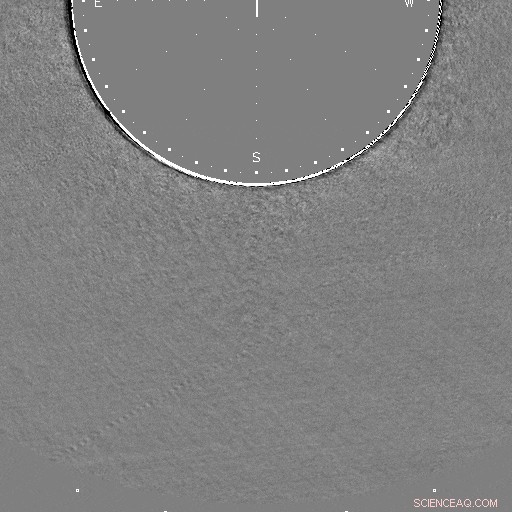
Gegevens van het Mauna Loa Solar Observatory op Hawaï tonen een straal materiaal die op 21 januari nabij de zuidpool van de zon wordt uitgeworpen. 2020 (UTC). Deze verschilafbeelding wordt gemaakt door de pixels van de vorige afbeelding af te trekken van de huidige afbeelding om wijzigingen te markeren. Krediet:Mauna Loa Solar Observatory/K-Cor
Parker zonnesonde
Vroege gegevens van de korte passage van Parker Solar Probe langs de zon tijdens de WHPI-campagne tonen een zonnewindsysteem dat dynamischer is dan wat zichtbaar is in waarnemingen nabij de aarde. Vooral, wetenschappers hopen dat de volledige set gegevens - in mei 2020 gedownlinkt naar de aarde - dynamische structuren zal onthullen, zoals kleine coronale massa-ejecties en magnetische fluxkabels in hun vroege ontwikkelingsstadia, dat kan niet worden gezien met andere observatoria die van verder weg kijken. Zo verbindende structuren, voorheen te klein of te ver weg om te zien, met zonnewind en metingen in de buurt van de aarde kunnen wetenschappers helpen beter te begrijpen hoe de zonnewind tijdens zijn leven verandert en hoe zijn oorsprong in de buurt van de zon zijn gedrag in het hele zonnestelsel beïnvloedt.
Zonne-observatorium Mauna Loa
Parker Solar Probe's close-upbeelden van zonnewindstructuren worden aangevuld met zonne-observatoria op aarde en in de ruimte, die een groter gezichtsveld hebben om zonnewindstructuren vast te leggen.
Gegevens van het Mauna Loa Solar Observatory in Hawaï tonen een straal materiaal die op 21 januari nabij de zuidpool van de zon wordt uitgeworpen. 2020. Coronale jets zoals deze zijn een zonnewindfunctie die wetenschappers met Parker Solar Probe van dichterbij hopen te observeren, omdat de mechanismen die ze creëren meer licht kunnen werpen op de geboorte en versnelling van de zonnewind.
"Het zou buitengewoon gelukkig zijn als Parker Solar Probe deze jet zou observeren, omdat het niet lang na zijn vorming informatie zou geven over plasma en het veld in en rond de jet, " zei Joan Burkepile, hoofdwetenschapper voor het Coronal Solar Magnetism Observatory K-coronagraph-instrument van het Mauna Loa Solar Observatory, die deze beelden vastlegde.
Observatorium voor zonne- en terrestrische relaties
Along with observations of the solar wind from Parker Solar Probe and near Earth, scientists also have detailed images of the sun and its atmosphere from spacecraft like NASA's Solar Dynamics Observatory and the Solar and Terrestrial Relations Observatory. NASA's Solar and Terrestrial Relations Observatory, or STEREO, has a distinct view of the sun from its vantage point about 78 degrees away from Earth.
During this WHPI campaign, scientists took advantage of this unique viewing angle. From Jan. 21-23—when Parker Solar Probe and STEREO were aligned—the STEREO mission team increased the exposure length and frequency of images taken by its coronagraph, revealing fine structures in the solar wind as they speed out from the sun.
These difference images are created by subtracting the pixels of a previous image from the current image to highlight changes—here, revealing a small CME that would otherwise be difficult to see.
The Solar Dynamics Observatory, or SDO, takes high-resolution views of the entire sun, revealing fine details on the solar surface and the lower solar atmosphere. These images were captured in a wavelength of extreme ultraviolet light at 171 Angstroms, highlighting the quiet parts of the sun's outer atmosphere, de corona. This data—along with SDO's images in other wavelengths—maps much of the sun's activity, allowing scientists to connect solar wind measurements from Parker Solar Probe and other spacecraft with their possible origins on the sun.
Modeling the Data
Ideaal, scientists could use these images to readily pinpoint the region on the sun that produced a particular stream of solar wind measured by Parker Solar Probe—but identifying the source of any given solar wind stream observed by a spacecraft is not simple. In het algemeen, the magnetic field lines that guide the solar wind's movement flow out of the Northern half of the sun point in the opposite direction than they do in the Southern half. Begin 2020, Parker Solar Probe's position was right at the boundary between the two—an area known as the heliospheric current sheet.
"For this perihelion, Parker Solar Probe was very close to the current sheet, so a little nudge one way or the other would make the magnetic footpoint shift to the south or north pole, " said Nick Arge, a solar scientist at NASA's Goddard Space Flight Center in Greenbelt, Maryland. "We were on the tipping point where sometimes it went north, sometimes south."
Predicting which side of the tipping point Parker Solar Probe was on was the responsibility of the modeling teams. Using what we know about the sun's magnetic field and the clues we can glean from distant images of the sun, they made day-by-day predictions of where, precisely, on the sun birthed the solar wind that Parker would fly through on a given day. Several modeling groups made daily attempts to answer just that question.
Using measurements of the magnetic field at the sun's surface, each group made a daily prediction for the source region producing the solar wind that Parker Solar Probe was flying through.
Arge worked with Shaela Jones, a solar scientist at NASA Goddard who did daily forecasting during the WHPI campaign, using a model originally developed by Arge and colleagues Yi-Ming Wang and Neil Sheeley, called the WSA model. According to their forecasts, the predicted source of the solar wind switched between hemispheres suddenly during the observation campaign, because Earth's orbit at the time was also closely aligned with the heliospheric current sheet—that region where the direction of magnetic polarity and the source of the solar wind switches between north and south. They predicted that Parker Solar Probe, flying in a similar plane as Earth, would experience similar switches in solar wind source and magnetic polarity as it flew near the sun.
Solar wind models rely on daily measurements of the sun's surface magnetic field—the black and white image underlaid. This particular model used measurements from the National Solar Observatory's Global Oscillation Network Group and a model that focuses on predicting how the sun's surface magnetic field will change over several days. Creating these magnetic surface maps is a complicated and imperfect process unto itself, and some of the modeling groups participating in the WHPI campaign also used magnetic measurements from multiple observatories. Dit, along with differences in each group's models, created a spread of predictions that sometimes placed the source of Parker Solar Probe's solar wind stream in two different hemispheres of the sun. But given the inherent uncertainty in modeling the solar wind's source, these different predictions can actually make for more robust operations.
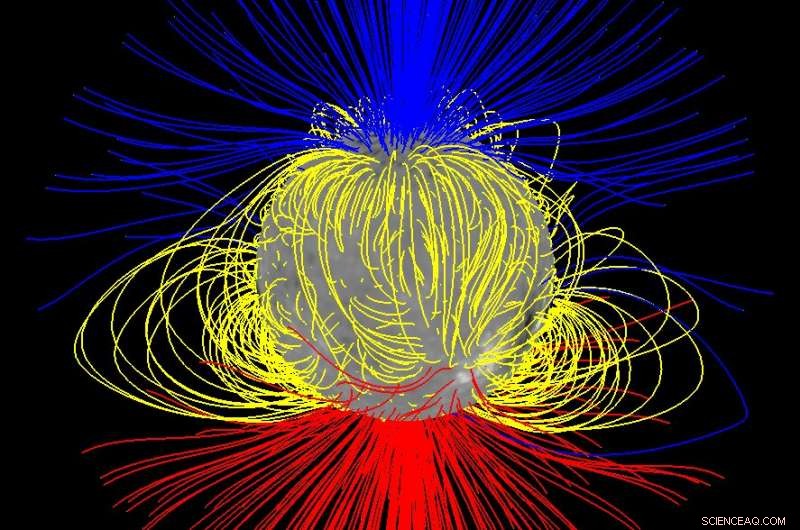
The sun's "open" magnetic field — shown in this model in blue and red, with looped or closed field shown in yellow — primarily comes from near the Sun's north and south poles during solar minimum, but it spreads out to fill space converging near the Sun's equator. Credit:NASA/Nick Arge
"If you can observe the sun in two different places with two telescopes, you have a better chance to get the right spot, " zei Jones.
Poker Flat Incoherent Scatter Radar
The solar wind carries with it both an enormous amount of energy and the embedded magnetic field of the sun. When it reaches Earth, it can ring our planet's natural magnetic field like a bell, making it bend and deform—which produces a measurable change in magnetic field strength at certain points on Earth's surface. We track those changes because magnetic field oscillations can lead to a host of space weather effects that interfere with spacecraft or even, zo nu en dan, utility grids on the ground.
A host of ground-based magnetometers have tracked these effects since the 1850s, and they're one of the many sets of data scientists are gathering in connection with this campaign. Other ground-based instruments can reveal the invisible effects of space weather in our atmosphere. One such system is the Poker Flat Incoherent Scatter Radar, or PFISR—a radar system based at the Poker Flat Research Range near Fairbanks, Alaska.
This radar is specially tuned to detect one of most reliable indicators of a disturbance in Earth's magnetic field:electrons in Earth's upper atmosphere. These electrons are created when particles trapped in the magnetosphere are sent zooming into Earth's atmosphere by a complex series of events, a set of circumstances known as a magnetospheric substorm.
On Jan. 16, PFISR measured the changing electrons in Earth's upper atmosphere during one such substorm. During a substorm, particles cascade into the upper atmosphere, not only creating the shower of electrons measured by the radar, but driving a more visible effect:the aurora. PFISR uses multiple beams of radar oriented in different directions, which allowed scientists to build up a three-dimensional picture of how electrons in the atmosphere changed throughout the substorm.
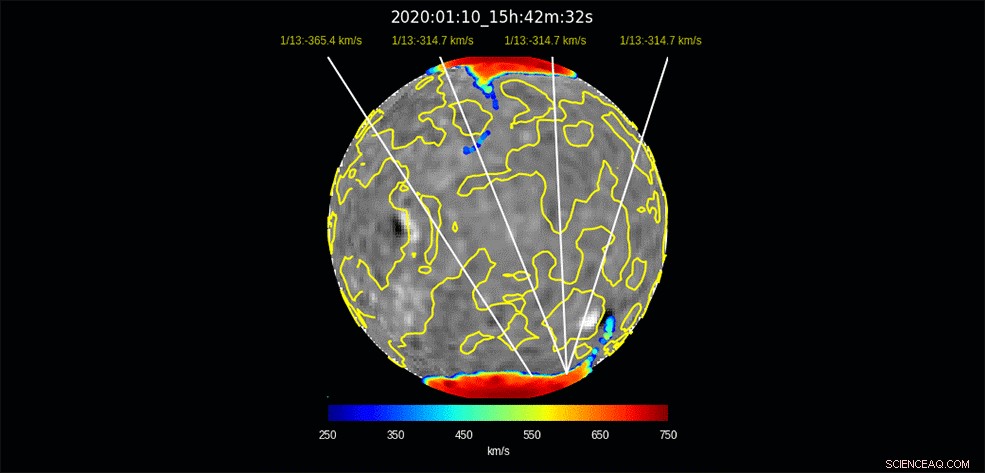
This model run — produced by Nick Arge and Shaela Jones using the WSA model — illustrates the predicted origin for solar wind that will impact Earth days later, spanning Jan. 10 – Feb. 3, 2020. The colored regions near the sun's north and south poles show the regions from which the solar wind flows out, with red regions showing a faster flow and blue regions showing a slower flow. The yellow lines on the sun divide areas of opposite magnetic polarity. The white lines indicate the predicted points of origin for the solar wind arriving at Earth at the given date. The black and white underlaid image shows a map of the magnetic field at the sun's surface, the basis for the model's predictions. The black regions are where the magnetic field points inward, toward the sun, and white regions are where the field points outward, away from the sun. Credit:NASA/Nick Arge/Shaela Jones
Because this substorm took place so early in the observation campaign—only one day after data collection began—it's unlikely that it was caused by conditions on the sun observed during the campaign. Maar toch, the connection between magnetospheric substorms and the broader, global-scale effects created by the solar wind—called geomagnetic storms—isn't entirely understood.
"This substorm didn't happen during a geomagnetic storm time, " said Roger Varney, principal investigator for PFISR at SRI International in Menlo Park, Californië. "The solar wind during this event is fluctuating, but not particularly strongly—it's basically background noise. But solar wind is basically never steady; it's constantly putting some energy into the magnetosphere."
This deposit of energy into Earth's magnetic system has far-reaching effects:for one, changes in the composition and density of Earth's upper atmosphere can garble communications and navigation signals, an effect often characterized by total electron content. Changes in density can also affect the orbits of satellites to great degree, introducing uncertainty about precise position.
MAVEN
Earth isn't the only planet where the solar wind has measurable effects—and studying other worlds in our solar system can help scientists understand some of the solar wind's effects on Earth and how it influenced the evolution of Earth and other worlds throughout the solar system's history.
At Mars, the solar wind coupled with Mars' lack of a global magnetic field may be a major factor in the dry, barren world the Red Planet is today. Though Mars was once much like Earth—warm, with liquid water and a thick atmosphere—the planet has changed drastically over the course of its four-billion-year history, with most of its atmosphere being stripped away to space. With similar processes observed here on Earth, scientists leverage understanding of solar-planetary interactions at Mars to determine how processes leading to atmospheric escape has the ability to change whether a planet is habitable or not. Vandaag, the Mars Atmosphere and Volatile Evolution mission, or MAVEN, studies these processes at Mars. MAVEN observations at Mars are available for this latest WHPI campaign.
Over the coming months, heliophysicists around the world will begin to study data from these observatories in depth, hoping to draw connections that reveal new knowledge about the sun and its changes that influence Earth and space across the solar system.
Parker Solar Probe is part of the NASA Heliophysics Living with a Star program to explore aspects of the sun-Earth system that directly affect life and society. The Living with a Star program is managed by the agency's Goddard Space Flight Center in Greenbelt, Maryland, for NASA's Science Mission Directorate in Washington. The Johns Hopkins Applied Physics Laboratory in Laurel, Maryland, ontworpen, built and operates the spacecraft and manages the mission for NASA.
 Hoge druk doet waterstofvarianten instorten
Hoge druk doet waterstofvarianten instorten Welke kleuren absorberen meer warmte?
Welke kleuren absorberen meer warmte?  Wat is thermokoppel?
Wat is thermokoppel?  Op oxide-zeoliet gebaseerd composietkatalysatorconcept maakt syngaschemie mogelijk die verder gaat dan Fischer-Tropsch-synthese
Op oxide-zeoliet gebaseerd composietkatalysatorconcept maakt syngaschemie mogelijk die verder gaat dan Fischer-Tropsch-synthese Nieuwe techniek om de chemische samenstelling en structuur van monsters te karakteriseren
Nieuwe techniek om de chemische samenstelling en structuur van monsters te karakteriseren
 Overstromingen maken geen einde aan de jarenlange droogte in Australië
Overstromingen maken geen einde aan de jarenlange droogte in Australië 5 Centrale thema's van de biologie
5 Centrale thema's van de biologie Ongerepte bossen bestrijden klimaatverandering, maar geconfronteerd worden met bedreigingen
Ongerepte bossen bestrijden klimaatverandering, maar geconfronteerd worden met bedreigingen Hoe het verbieden van plastic tassen New York kan helpen de klimaatverandering te verminderen
Hoe het verbieden van plastic tassen New York kan helpen de klimaatverandering te verminderen Nieuwe studie toont aan dat vegetatie de toekomst van de watercyclus bepaalt
Nieuwe studie toont aan dat vegetatie de toekomst van de watercyclus bepaalt
Hoofdlijnen
- Wat is een gemakkelijke manier om spieren in het menselijk lichaam te onthouden?
- Hoe biologische antropologie werkt
- De chemische samenstelling van groene planten
In veel opzichten verschillen planten niet erg van mensen. Als je een plant en een persoon in hun basiselementen zou afbreken, zou je merken dat beide meer koolstof, waterstof en zuurstof bevatten dan w
- Wanneer wordt een mutatie in een DNA-molecuul doorgegeven aan nakomelingen?
- Is de computer een goed model voor de hersenen?
- 10 toepassingen voor zuurstof
- Cellen geprogrammeerd als computers om ziekten te bestrijden
- Maagdelijke vrouwelijke spinnen gevonden bereid om zichzelf over te geven om levend te worden opgegeten door spinnetjes
- Verschillende soorten enzymen
- Voyager 2-ingenieurs werken aan het herstellen van de normale werking
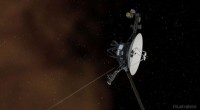
- Het elektrische zand van Titan:de korrels die de maan van Saturnus bedekken, werken als plakkerige pinda's
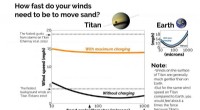
- Japanse miljardair maakt zich klaar voor ruimtemissie in december
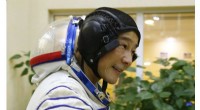
- ESA's nieuwe Mars-orbiter bereidt zich voor op eerste wetenschap
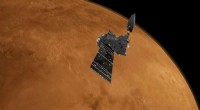
- NASA bestudeert gedeelde Venus-wetenschappelijke doelstellingen met het Russische Ruimteonderzoeksinstituut
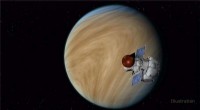
 NASA meet de regensnelheid in de kleine tropische storm Henrietta
NASA meet de regensnelheid in de kleine tropische storm Henrietta Vezeloptische trillingssensoren kunnen treinongevallen voorkomen
Vezeloptische trillingssensoren kunnen treinongevallen voorkomen Ondanks hardhandig optreden, junknieuws floreert nog steeds op sociale media
Ondanks hardhandig optreden, junknieuws floreert nog steeds op sociale media Onderzoeksgroep heeft een defectbestendige superlegering gemaakt die 3D-geprint kan worden
Onderzoeksgroep heeft een defectbestendige superlegering gemaakt die 3D-geprint kan worden Veelbelovende kandidaat-geneesmiddelen voor prostaatkanker geïdentificeerd
Veelbelovende kandidaat-geneesmiddelen voor prostaatkanker geïdentificeerd Aardgasinformatie
Aardgasinformatie In de regenwouden van Brazilië, de ergste branden zullen waarschijnlijk nog komen
In de regenwouden van Brazilië, de ergste branden zullen waarschijnlijk nog komen MagicMark:een markeringsmenu met 2D-richting en 3D-diepte-informatie
MagicMark:een markeringsmenu met 2D-richting en 3D-diepte-informatie
- Elektronica
- Biologie
- Zonsverduistering
- Wiskunde
- French | Italian | Spanish | Portuguese | Swedish | German | Dutch | Danish | Norway |

-
Wetenschap © https://nl.scienceaq.com

